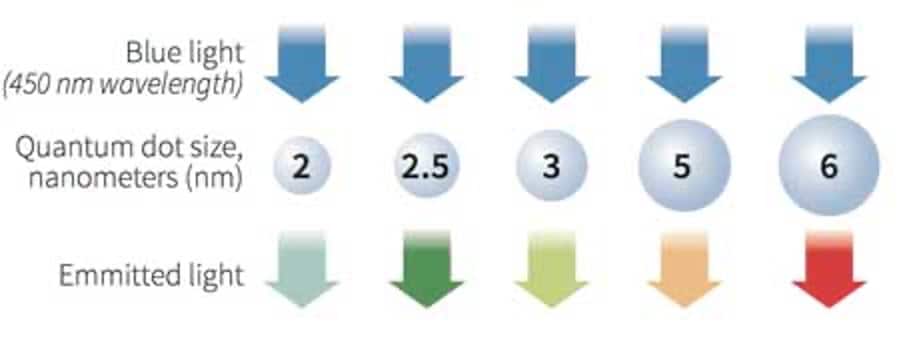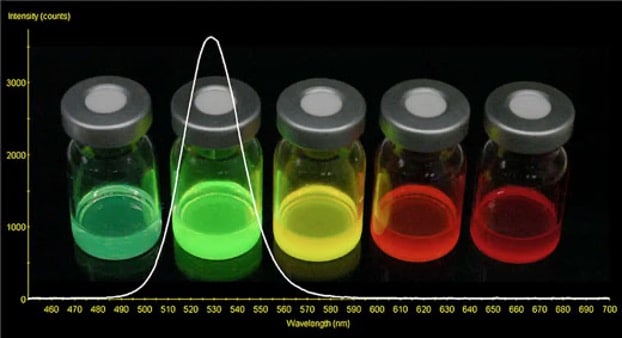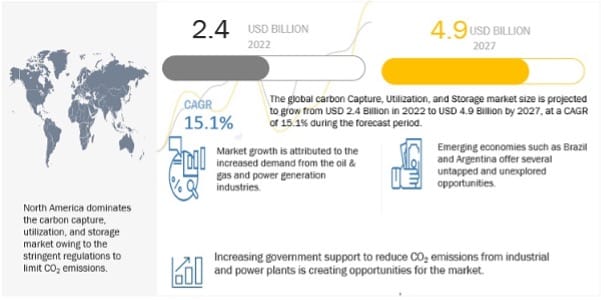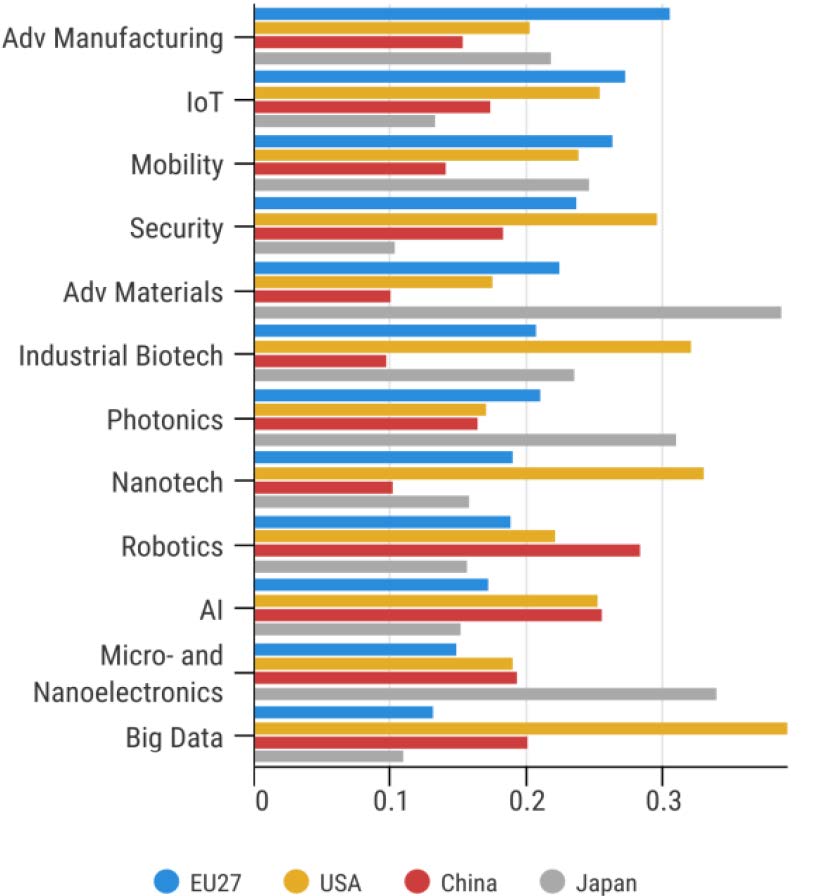Quantum dots are nanoscale man-made semiconductor crystals (nanocrystals) that have the ability to convert a spectrum of light into different colours and have been gaining significant attention in recent years due to their unique properties and potential applications in a wide range of industries. This post aims to provide an overview of the market potential of quantum dots and their usage in various fields.
Quantum dots are nanostructures that can exhibit a wide range of properties. Due to their unique electronic characteristics, they can be utilized as active materials in single-electron transistors, for instance. The exhibited properties are determined not only by their size, but also by their material, shape, composition, and structure, such as whether they are solid or porous. It is a dependable manufacturing technology that exploits the properties of quantum dots for a variety of applications in fields such as catalysis, electronics, photonics, information storage, imaging, medicine, and sensing.
Due to the fact that certain biological molecules are capable of molecular recognition and self-assembly, nanocrystals have the potential to become an essential component of self-assembled functional nanodevices.In addition, the atom-like energy states of QDs contribute to their unique optical properties, such as a particle-size-dependent fluorescence wavelength; an effect utilized in the fabrication of optical probes for biological and medical imaging.

Each Quantum dot emits a different colour depending on its size. (Image: RNGS Reuters/Nanosys)
Market Potential of Quantum Dots
The value of the global quantum dots market was USD 4.4 billion in 2020 and is projected to reach USD 14.5 billion by 2027, expanding at a CAGR of 18.8% from 2021 to 2027 (depending on the source). This expansion can be attributed to the growing demand for quantum dots in the display industry, the largest application segment for quantum dots. Quantum dots offer numerous advantages over conventional display technologies, including a wider color gamut, enhanced color accuracy, and greater energy efficiency. In addition, the atom-like energy states of QDs contribute to their unique optical properties, such as a particle-size-dependent fluorescence wavelength; an effect utilized in the fabrication of optical probes for biological and medical imaging.
Apart from the display industry, quantum dots have a vast range of potential applications in other industries such as healthcare, energy, and security. In healthcare, quantum dots are being used in diagnostics, imaging, and drug delivery. Quantum dots have also shown potential in the field of solar cells, where they can improve the efficiency of solar cells by capturing a broader range of light. Additionally, quantum dots have been used in security applications such as authentication and anti-counterfeiting.
Usage Potential of Quantum Dots:
- Display Technology
As mentioned earlier, quantum dots offer significant advantages over traditional display technologies, such as liquid crystal displays (LCDs) and organic light-emitting diodes (OLEDs). Quantum dots enable displays to produce more accurate and vivid colors while consuming less energy. They are also resistant to degradation and provide longer lifespan to the displays.
- Healthcare
Quantum dots have shown potential in various healthcare applications such as diagnostics, imaging, and drug delivery. When activated by light, quantum dots can emit specific wavelengths as fluorescent probes. This makes them sensitive and selective sensors for proteins, nucleic acids, and tiny compounds. Quantum dots can be functionalized with ligands or antibodies that preferentially attach to target biomolecules for immunoassays, DNA/RNA detection, and point-of-care testing. Their brightness, photostability, and multiplexing make them suitable for accurate and quick biomolecule detection, improving diagnostics and disease monitoring.
Quantum dots are promising contrast agents in fluorescence microscopy and MRI. Their brilliant and stable fluorescence can mark and track cells, tissues, or biomolecules in real time, revealing cellular activities, tissue architecture, and disease development. Quantum dots’ magnetic characteristics enhance contrast and imaging sensitivity in MRI. Quantum dots can be made with unique surface qualities to target specific tissues or cells for precise, non-invasive disease imaging.

Vials of quantum dots producing vivid colors. For instance, a cadmium-based quantum dot showing pure, highly specific green color response. (Image: NASA)
Drug delivery methods can increase efficacy and safety with quantum dots. Their small size, high surface area, and customizable surface characteristics make them suitable drug carriers. Quantum dots can be functionalized with targeting ligands that bind to receptors or biomolecules on target cells to selectively absorb and accumulate. Targeted medication administration reduces off-target effects and increases drug concentration at the site of action, improving therapeutic outcomes and lowering systemic toxicity. Quantum dots can also release medications slowly, prolonging their therapeutic effect.
- Energy
Quantum dots can improve the efficiency of solar cells by capturing a broader range of light. Using quantum dots to manufacture solar cells has a number of advantages over alternative methods. They can be produced in an energy-saving room-temperature process from abundant, inexpensive materials that do not require extensive purification, unlike silicon, and they can be applied to a variety of inexpensive and even flexible substrate materials, such as lightweight plastics.
A promising method for quantum dot solar cells is the use of a semiconductor ink, which aims to enable the coating of large areas of solar cell substrates in a single deposition step, thereby eradicating the tens of deposition steps required by the previous layer-by-layer method. Although using quantum dots as the basis for solar cells is not a novel concept, attempts to create photovoltaic devices have not yet obtained a sufficiently high conversion efficiency of sunlight into electricity.
- Security
Anti-counterfeiting: Quantum dots in security inks or identifiers create distinctive, unforgeable patterns. Quantum dots emit light at specific wavelengths when stimulated by ultraviolet light, which can be used as a signature or barcode for authentication. Using specialized detectors, quantum dots can validate the authenticity of banknotes, passports, and other vital documents.
Quantum dots can be utilized as quantum light sources for secure communication. Quantum key distribution (QKD) uses quantum mechanics to create secure communication channels utilizing single photons from quantum dots. Due to their high quantum yield and wavelength-tunable emission, quantum dots hold promise for secure communications.
Quantum dots are tamper-evident labels that help secure shipments and merchandise. Quantum dots can be combined with inks or coatings that change color or emit light when tampered with, thereby indicating product or packaging corruption. This protects against forgery and manipulation.
Quantum dots can be used for fingerprint and iris recognition for biometric security. As fluorescent labels, quantum dots enhance the sensitivity and accuracy of biometric sensors. Quantum dots can detect unique DNA sequences in systems that rely on DNA for authentication.
Quantum cryptography: Using quantum physics, quantum dots can securely transmit cryptographic keys. Quantum cryptography devices use quantum dots as light sources or detectors to generate and detect quantum states for secure key exchange.
In conclusion,
quantum dots represent a cutting-edge technology that holds great promise for the future. With their unique properties and versatility, they offer a wide range of potential applications across various industries. From displays to lighting, to biomedical imaging, to solar cells and beyond, quantum dots are poised to revolutionize multiple sectors. Their ability to manipulate light at the nanoscale opens up new possibilities for enhanced performance and improved efficiency in existing technologies, while also paving the way for entirely new applications. As research and development in quantum dots continue to advance, the market potential for this technology is substantial.
Quantum dots are undoubtedly an attractive alternative to traditional technologies, and their vast usage potential is just beginning to be explored, making them a technology to watch in the coming years. The future of quantum dots is bright, and their impact on various industries is likely to be profound.



